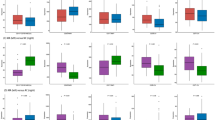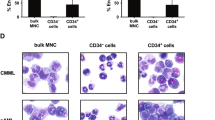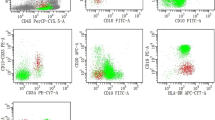Abstract
Myelodysplasia (MDS) is mostly characterized by a normal or increased number of normoblasts in the bone marrow and an impaired in vitro colony formation. In the present study we analyzed whether this might be due to a disconnection between proliferation and differentiation. CD34+/CD36− sorted bone marrow cells of 18 MDS patients were cultured in a clonogenic and suspension culture assay in the presence of erythropoietin (Epo) and mast cell growth factor (MGF). Burst-forming units erythroid (BFU-E, 75 ± 88/104 CD34+ cells, X ± s.d.) and colony-forming units E (CFU-E) were observed in eight of the 13 cases (62%) with refractory anemia with or without ring sideroblasts (RA and RARS) and one of the five cases with RA with excess of blasts or in transformation (RAEB and RAEB-T). Suspension cultures with CD34+/CD36− sorted cells with Epo plus MGF demonstrated an 8.9 ± 6.5-fold expansion after 7 days in cases with >10 BFU-E/104 CD34+/CD36− cells while cases with <10 bfu-e/104 CD34+/CD36− cells demonstrated 1.0 ± 0.8-fold expansion especially in cases with RAEB/RAEB-T. FACS and morphology analysis after 7 days of suspension culture demonstrated partial differentiation along the erythroid lineage in cases with RA/RARS (75%) and RAEB/RAEB-T (66%) reflected by the presence of erythroblasts and normoblasts with variable expression of CD34, CD36 and Glycophorin A. In cases with erythroid colony formation 69 ± 24% of the cells were CD34−/CD36+ and in cases with <10 bfu-e/104 CD34+ cells 18 ± 16% of cells were CD34−/CD36+. Iron staining showed the presence of ring sideroblasts in two cases with RARS indicating that the cells originate from the abnormal erythroid clone. Finally, it was shown that cases with an impaired proliferative response demonstrate an enhanced binding of Annexin-V on CD34+ cells during the first days of the cell suspension culture phase. These results suggest that a defect in the proliferative response is most pronouncedly expressed in MDS whereas a subpopulation of cells retain the capacity to differentiate between transition to a terminated stage.
This is a preview of subscription content, access via your institution
Access options
Subscribe to this journal
Receive 12 print issues and online access
$259.00 per year
only $21.58 per issue
Buy this article
- Purchase on Springer Link
- Instant access to full article PDF
Prices may be subject to local taxes which are calculated during checkout
Similar content being viewed by others
Author information
Authors and Affiliations
Rights and permissions
About this article
Cite this article
Brada, S., de Wolf, J., Hendriks, D. et al. CD34+/CD36− cells from myelodysplasia patients have a limited capacity to proliferate but can differentiate in response to Epo and MGF stimulation. Leukemia 12, 882–886 (1998). https://doi.org/10.1038/sj.leu.2401046
Received:
Accepted:
Published:
Issue Date:
DOI: https://doi.org/10.1038/sj.leu.2401046
Keywords
This article is cited by
-
Myelodysplasia and apoptosis: new insights into ineffective erythropoiesis
Medical Oncology (2000)



